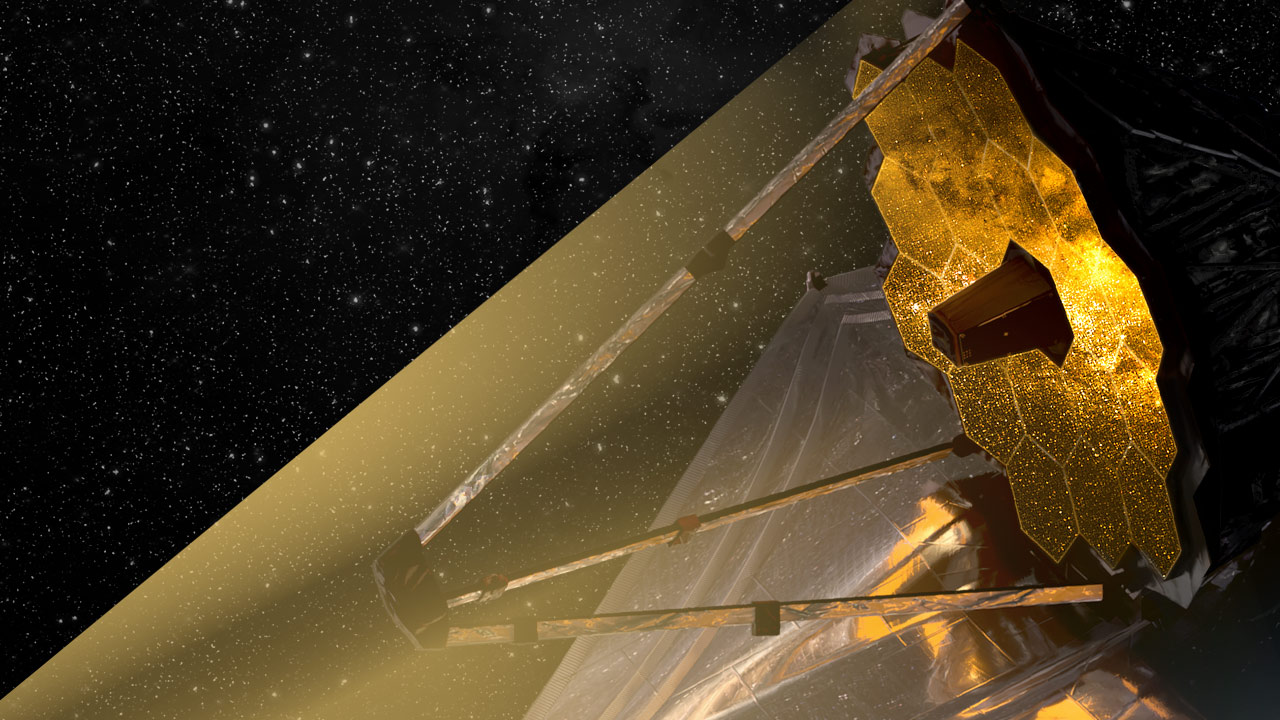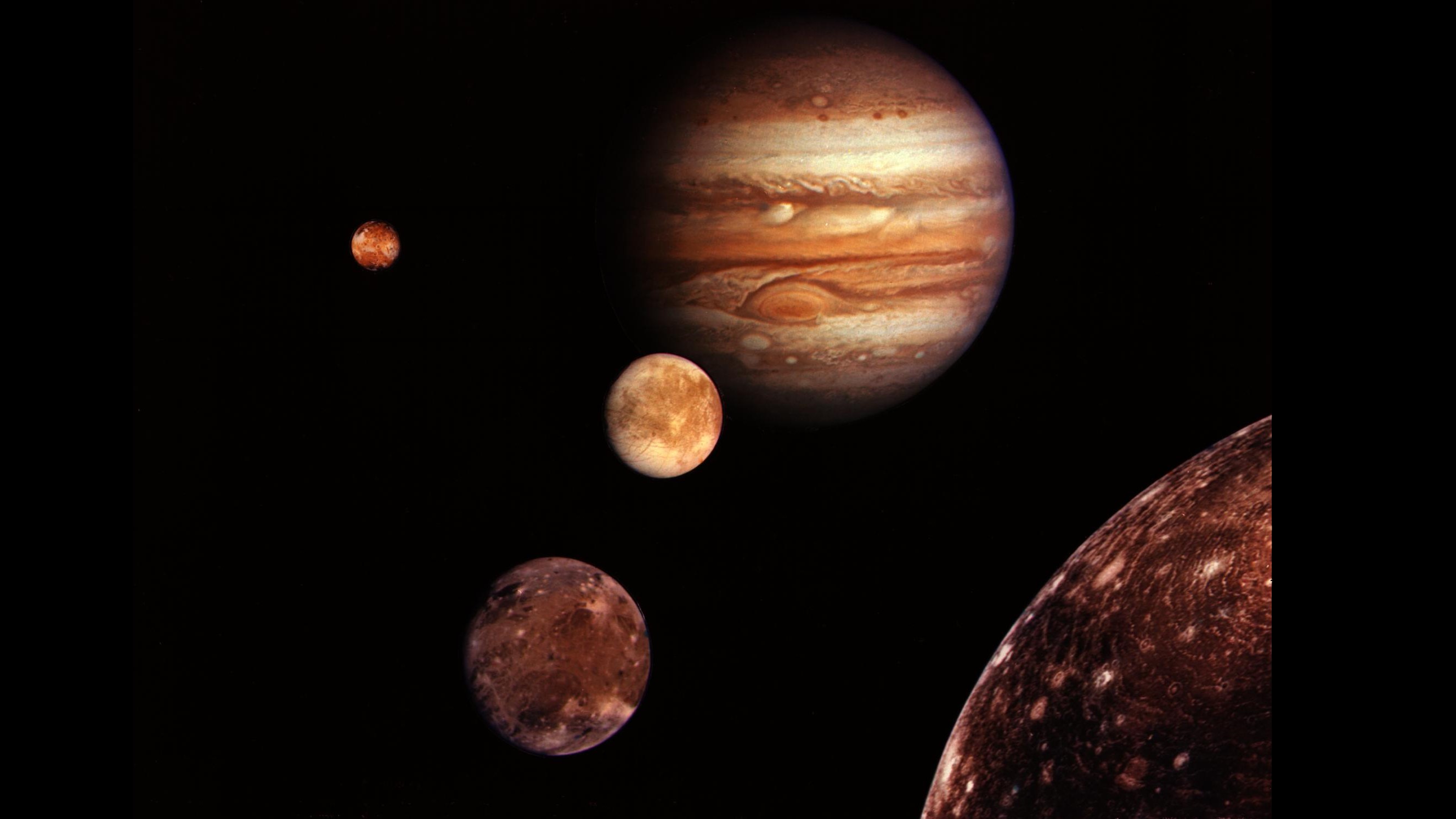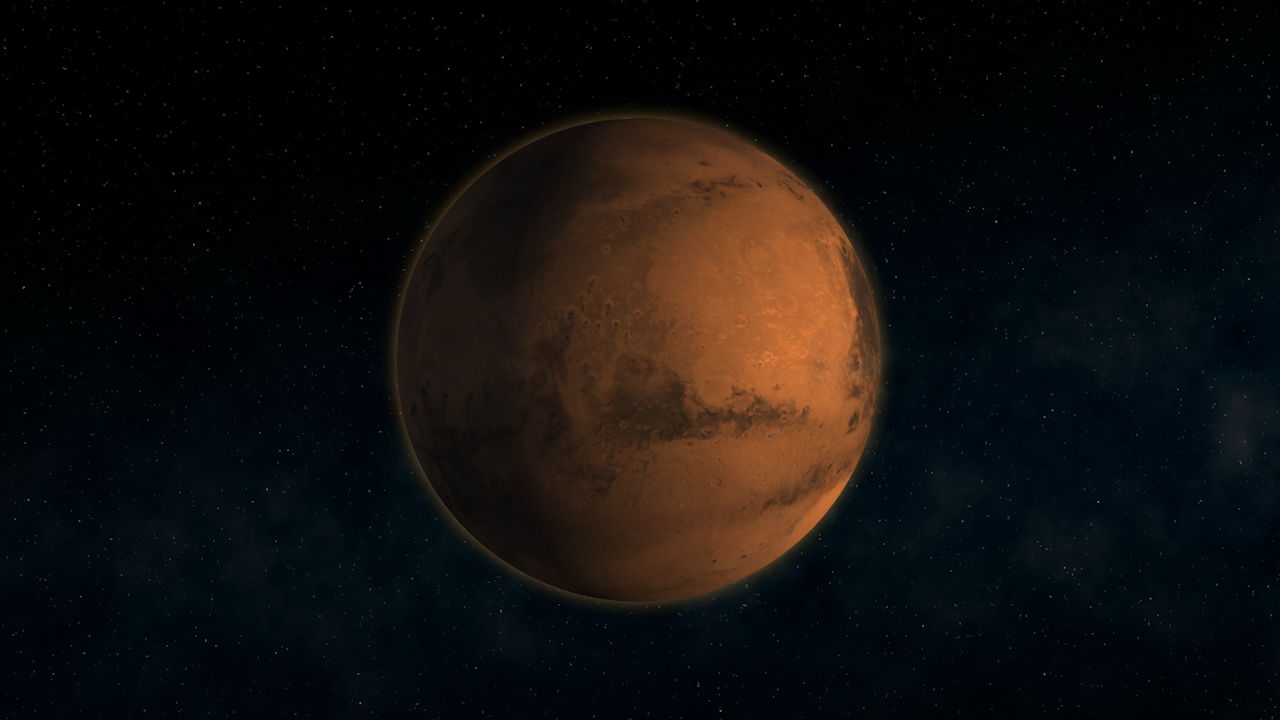NASA's James Webb Space Telescope will change the way we see our solar system
Designed to unveil distant galaxies, Webb will also cast our stellar neighborhood in a whole new light.

Up on the monitor in the James Webb Space Telescope Flight Control Room is an image of the planet Jupiter. Although slightly blurred, it is unmistakable, its characteristic stripes and huge Great Red Spot beaming down on a group of reporters touring the room at the Space Telescope Science Institute in Baltimore.
Carl Starr, Webb's Mission Operations Manager for the James Webb Space Telescope, clicks a computer mouse, and the next image appears. "We decided to apply the coronagraph to it," he said, referring to a telescope attachment that can block out a bright object to observe what surrounds it. Jupiter suddenly darkens as its moons and faint rings materialize.
The images of Jupiter that Starr has shown the group are the last of a collection of unreleased test photos taken as part of the telescope's alignment and calibration process. "So you see, these are just hot off the presses," Starr said. "These images are raw images that haven't been doctored, haven't been cleaned up. But this is what the telescope is doing."
Gallery: James Webb Space Telescope's 1st photos
Live updates: NASA's James Webb Space Telescope mission
NASA will release the first official images from Webb on Tuesday (July 12) during a live broadcast held to mark the telescope's transition into a fully active scientific instrument. But these striking test images are far from the last time the telescope will focus its gaze on Jupiter. In fact, Webb will soon turn its gaze on many objects in our own solar system. Although the telescope was built to observe distant galaxies, it will also allow scientists to observe our solar system in completely new ways.
"Webb is designed to be an incredibly powerful tool that will see out to the edge of the cosmos, the most distant galaxies, maybe even the first stars that formed," Heidi Hammel, Vice President of the Association of Universities for Research in Astronomy and an interdisciplinary scientist working on Webb, told Space.com. "But because it is so powerful, it has capabilities that we can apply everywhere in the cosmos, even in our local neighborhood, the solar system."
In a new light
Although Webb was always meant to focus on the distant cosmos, scientists started scheming to use it to observe the solar system early on. In 2002, NASA chose Hammel to work on the mission as an interdisciplinary scientist, helping Webb's various instrument teams develop plans to study the solar system.
Get the Space.com Newsletter
Breaking space news, the latest updates on rocket launches, skywatching events and more!
Many of those plans rely on instruments called spectrographs. These instruments capture what scientists call spectra — representations of the different wavelengths of light emitted and absorbed by anything from a star to a planet's atmosphere to interstellar dust. Because different substances emit and absorb light in distinctive ways, scientists have used spectrographs to find out what much of the universe is made of.
"Webb is designed to be an incredibly powerful tool that will see out to the edge of the cosmos, the most distant galaxies, maybe even the first stars that formed. But because it is so powerful, it has capabilities that we can apply everywhere in the cosmos, even in our local neighborhood, the solar system."
— Heidi Hammel
Webb is an infrared telescope, meaning its spectrographs detect wavelengths of light longer than the human eye can see, revealing details about what makes up the cosmos that observatories focusing on visible and ultraviolet spectra, including the venerable Hubble Space Telescope, cannot. Infrared capability is vital for gleaning details about faraway stars, but it also enables the observatory to investigate details of our solar system that have long eluded scientists.
"There is so much molecular chemistry that manifests itself in the infrared part of the spectrum," Hammel said.
Other aspects of the telescope, most notably its unprecedented sensitivity, enable Webb to observe faint phenomena both near and far. And where telescopes on Earth struggle to examine objects close to something extremely bright, like Jupiter's moons, Webb's perch in deep space and the coronagraph Starr demonstrated give the observatory new power.
"With Earth-bound telescopes, the scattered light from Jupiter is spread out by the Earth's atmosphere and contaminates a pretty large region," Hammel said. With Webb, in contrast, "the light from Jupiter is going to be contained to Jupiter."

To Jupiter and beyond
Scientists won't wait long to turn Webb's gaze on our solar system's largest planet. Jupiter, as well as its moons and rings, is included in a program designed to broadly release data from the observatory's first five months. The early cornucopia is meant to give scientists a chance to learn to use Webb's data effectively.
From these observations, scientists hope to better understand Jupiter's weather, temperature, composition and auroral activity — lights painted across the sky by charged particles from the sun hitting a planet's atmosphere. The data will also help scientists to study Jupiter's rings, how they might have formed, and where they might have come from.
Researchers will also try to map out plumes of vapor rising from two of Jupiter’s moons — volcano-covered Io and icy Ganymede. On Io, these come from its many volcanoes, but some evidence from Hubble suggests that another one of Jupiter’s icy moons, Europa, could spit out plumes of water vapor. (Europa isn't alone: NASA's Saturn explorer Cassini gathered clearer data suggesting plumes of water vapor and tiny grains of ice rising from the surface of that planet's Enceladus.) Hammel said that in future research, scientists will use Webb to take spectra of the plumes on Europa and Enceladus in hopes of sniffing out what they are made of and whether they reveal any signs of life hiding in the ice-covered ocean.
"It's challenging, hard to do and may not be successful," she said. "But it's… the kind of program that only something like Webb can do right now.
Uranus and Neptune
When Hammel joined the Webb mission two decades ago, she immediately saw an opportunity to learn more about the planets that have long been a focus of her research — Uranus and Neptune, dubbed the ice giants. No spacecraft has targeted either planet since the late 1980s, when Hammel was part of the team collecting images from NASA's Voyager 2 probe during its epic tour of the solar system.
Much of scientists' recent knowledge of these worlds comes from Hubble's regular check-ins. "Powerful telescopes are the only tools we have to truly understand the dynamics and the chemistry in these atmospheres," she said.
Scientists will observe both Uranus and Neptune as part of a program that rewards scientists who helped shape Webb's path to launch with precious telescope time. Observation of Uranus will start in August, while Neptune will have to wait until next June.
Other scientists are also in line to analyze data gathered by the Mid-Infrared Instrument (MIRI) from the planets, aiming to learn more about their compositions, atmospheres, temperatures, and weather. MIRI measures longer wavelengths of light than any other instrument on Webb, helping to reveal data about the planets that was previously hidden.
In April, a study revealed a surprising fact about Neptune — it is cooling down, and no one knows why. Scientists expected the planet to heat up during its astronomical summer, but two decades of data revealed strange, uneven cooling. Scientists hope to use Webb to find an explanation for the unexpected colder temperatures.
"The exquisite sensitivity of the space telescope's mid-infrared instrument, MIRI, will provide unprecedented new maps of the chemistry and temperatures in Neptune's atmosphere," Leigh Fletcher, a planetary scientist at the University of Leicester in the U.K. and an author on the April study, said in a statement. MIRI will also help "better identify the nature of these recent changes," he said, referring to Neptune's cooling. Fletcher will lead the teams observing the two planets with Webb and is also part of the team doing the later analyses.
Mars
Apart from Earth, Mars is probably the most-studied planet in our solar system, with three active rovers and one lander currently exploring the planet. Still, Webb has something to add, particularly by teaming up with other Red Planet missions, including the Perseverance rover.
"Even objects like the planet Mars that we have explored with rovers and orbiters, we can use James Webb Space Telescope to get holistic global views of the chemistry happening on the surface or in the atmosphere," Hammel said.
Among other tasks, Webb will study the weather on Mars at a global scale. In 2018, NASA's Opportunity rover succumbed to a planet-wide dust storm that left the spacecraft unable to gather solar power. At the time, orbiters gathered information on the storm, but none could see the entire planet at once. If Webb can watch such a dust storm on Mars, its data might help scientists better understand these storms — and maybe even help future spacecraft endure them.
Using Webb's spectrographs to analyze Mars and its atmosphere, scientists hope to address some of our most crucial questions about the planet. For instance, why did the planet's lakes and oceans dry up? Webb's infrared vision allows it to track the history of water on the planet.

The quest to understand the history of water, which is crucial to life on Earth, feeds scientists' longstanding interest in whether life ever existed on Mars. Here, Webb can partner with the Perseverance rover's on-the-ground work, as well as future studies of its samples brought to Earth, to help researchers determine whether life ever existed on the planet, and if so, how long ago it might have died off.
Another lingering mystery is Curiosity rover detections of a strange, seasonal fluctuation in the amount of methane in Mars' atmosphere. On Earth, methane is produced by bacteria, but the chemical can also be made without life. A more detailed look at Mars' atmosphere might shed light on what is producing the methane and why its concentration could be changing with the Martian seasons.
Gaining a more detailed planet-wide view of Mars is especially useful as NASA prepares to send astronauts there in the 2030s.
"Having another spacecraft with the ability to observe Mars is fantastic, as NASA prepares to send astronauts to the moon, with an eye on the eventual human exploration of Mars," Lori Glaze, director of planetary science at NASA, said in a statement.
Our solar system, far and wide
Of course, Webb won't confine its solar system explorations to just planets. The telescope will examine much smaller objects like asteroids and comets, learning more about what they are made of and seeing some in greater detail than ever before. Webb is even ready to target any new comet that scientists might discover, Hammel said, through a program to respond to cosmic surprises that scientists couldn't plan for when telescope time was allocated.
Other projects will target the Kuiper Belt, the icy "graveyard of the solar system." Pluto, its moon Charon and thousands of other objects orbit the sun in this mysterious boundary zone of our solar system. Scientists believe that Kuiper Belt objects are left over from our solar system's beginnings and could help explain how our neighborhood formed.
"These are objects that are in the graveyard of solar system formation," Jonathan Lunine, an astronomer at Cornell University and a Webb interdisciplinary scientist like Hammel, said in a statement.
Other Webb science programs could bring insights to our solar system from beyond its boundaries. Scientists will study distant planetary systems in various stages of formation, perhaps shedding light on our own. Big-picture questions like where the universe's water comes from would also have implications for the formation of planets like Earth.
"Possibly most of the water in the universe existed as ice, coating tiny, tiny dust grains in interstellar clouds and molecular clouds," Klaus Pontoppidan, Webb project scientist at the Space Telescope Science Institute, told Space.com. "Webb is actually also a fantastic machine to measure and understand this ice."
In its first year out of the 20 that NASA currently hopes to coax from the long-awaited observatory, roughly 7% of Webb's total operating time will focus on the solar system. That fraction may seem small, and scientists will always stumble into new mysteries about Jupiter's Great Red Spot or the comets rattling through our solar system. But as the observatory focuses on so many parts of our solar system, it's impossible to predict what Webb might find, Hammel said.
Whatever comes next, Hammel can't wait.
"I'm just really looking forward to this first year," she said. "I think it's going to be amazing."
Follow us on Twitter @Spacedotcom and on Facebook.
Join our Space Forums to keep talking space on the latest missions, night sky and more! And if you have a news tip, correction or comment, let us know at: community@space.com.

Rebecca Sohn is a freelance science writer. She writes about a variety of science, health and environmental topics, and is particularly interested in how science impacts people's lives. She has been an intern at CalMatters and STAT, as well as a science fellow at Mashable. Rebecca, a native of the Boston area, studied English literature and minored in music at Skidmore College in Upstate New York and later studied science journalism at New York University.









